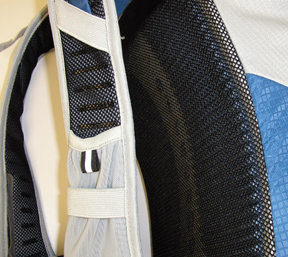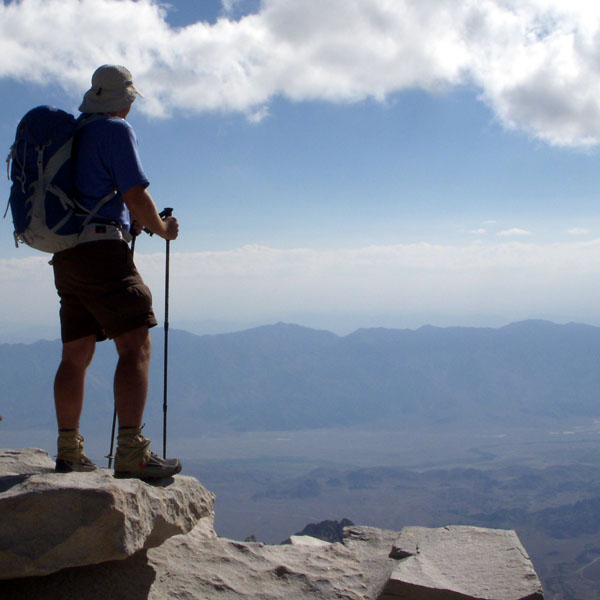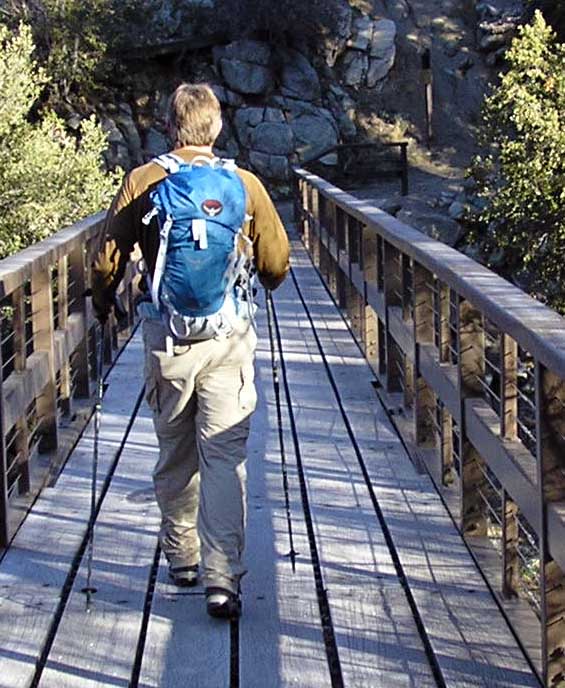|
Osprey Talon 33 Backpack
By Raymond Estrella
OWNER REVIEW
July 30, 2007
TESTER INFORMATION
|
NAME:
|
Raymond Estrella
|
|
EMAIL:
|
rayestrella@hotmail.com
|
|
AGE:
|
46
|
|
LOCATION:
|
Huntington Beach California USA
|
|
GENDER:
|
M
|
|
HEIGHT:
|
6' 3" (1.91 m)
|
|
WEIGHT:
|
200 lb (90.70 kg)
|
I have been backpacking for over 30 years, all over California, and in many of the western states and Minnesota. I hike year-round, and average 500+ miles (800+ km) per year. I have made a move to lightweight gear, and smaller volume packs. I start early and hike hard so as to enjoy the afternoons exploring. I usually take a freestanding tent and enjoy hot meals at night. If not hiking solo I am usually with my brother-in-law Dave or fiancée Jenn.
The Product
Manufacturer: Osprey
Web site: www.ospreypacks.com
Product: Talon 33
Size: Medium/Large (also available in Small/Medium)
Year manufactured: 2007
MSRP: N/A
Weight listed: 1 lb 14 oz (0.85 kg) Actual weight 1 lb 15.5 oz (0.89 kg)
Volume: 2000 cu in (33 L)
Load weight capacity suggested: to 26 lb (11.8 kg)
Color reviewed: Moonlight Blue (also available in Acid Green and Spicy Chili)
Warranty: (from company web site), "Our lifetime warranty covers defects in materials and craftsmanship for the lifetime of the backpack. Products found to be defective will be repaired or replaced at the discretion of our Warranty Department."

Product Description
The Osprey Talon 33 pack (hereafter referred to as the Talon or pack) is a blue top-loading pack that is positioned by the manufacturer for, "Day-long adventures, light overnighters, adventure racing for the expert light and fast backpacker to hardcore do-it-in-a-day alpinists". I do not do adventure racing but the rest of it describes me pretty accurately.
The blue sections of the pack are made of 70 x 100 denier "shadow check" (rip-stop) nylon. The grey areas are made from heavier 160 x 330 denier "shadow check" nylon. Although I can find no reference to it in the attached owner's manual or the web site, the fabrics feel as if they have a polyurethane coating applied to the inside surface. It is tacky feeling inside the body.
The main pack consists of a single top-loading sack. There are no dividers or pockets inside of it. A pretty beefy draw cord closes the top of the pack. The draw cord secures with a finger-pull style cord lock. A nylon strap with a lightweight quick-disconnect buckle goes over the top of the pack allowing it to be compressed. (This same strap can be used to carry a climbing rope.) A single side compression strap runs in a V-configuration on each side of the pack at the lower section. There are no straps for the upper portion of the pack. On the front of the pack is a pocket made of "stretch woven material with Lycra". This pocket is open at the top and secures with a centered fast-disconnect buckle. This same material is used for the side pockets, found under the compression straps.
The face of the pack is just loaded with goodies. Dual ice axe loops at the bottom correspond to bungee-style tie-offs above. There are four extra tie-off loops on the lower section and a tow-loop centered at the bottom of the Talon. A blinker patch is also thrown in for good measure. The Osprey logo is applied just below the blinker patch and three raptor "talons" are applied to either side, hence the name of the series.
A fixed lid bearing an Osprey logo patch sits on top of the Talon. It has a mesh pocket on the inside of it. The lid has a large pocket accessed by a zipper with a great zipper-pull. It is very easy to grab. Inside of the lid storage is another small pouch-type pocket that will fold out of the main area, and a key-ring clip. Here is a picture of it.

 The Talon does not have stays for support but rather utilizes a "mesh covered HDPE ridge molded foam backpanel with integrated air channels". The air channels run horizontally and are spaced about a half inch (13 mm) apart. The mesh is only attached at the outside edge of the frame sheet and floats away from it when the pack is off. Here are the air channels. The Talon does not have stays for support but rather utilizes a "mesh covered HDPE ridge molded foam backpanel with integrated air channels". The air channels run horizontally and are spaced about a half inch (13 mm) apart. The mesh is only attached at the outside edge of the frame sheet and floats away from it when the pack is off. Here are the air channels.
A section devoid of the ridged channels runs up the center of the panel and splits off to either side near the belt. The company calls this feature the "AirScape". It can be seen as the whitish area inside the mesh in the picture below.
The shoulder straps are made of mesh covered foam that has slots cut out of it to reduce weight. On each shoulder strap are two elastic loops to act as hydration tube guides, and one stretch material pocket sized to fit energy gel packets. Each shoulder strap has the normal adjustment straps at top going to the pack to pull it close to the back, and at the bottom going to the hip belt. A three position sternum strap crosses the shoulder harness and closes with a quick-connector that doubles as a whistle.
The Talon adjusts for torso length by pulling the harness yoke connecting the shoulder straps together (seen below) away from the hook and loop holding it in place. The harness may then be slid up or down using the arrows (one is visible in the center of the pack in the picture) to guide placement. A quick press once it is in place does the trick. The hook and loop is very strong.

The hip belt is constructed the same way as the shoulder harness. It has the normal Osprey "V" type routing of the adjustment strap. By pulling the straps towards the center instead of away it tightens the belt. Something new to me on both the hip belt and shoulder pads are D-ring keepers that keep the excess strap from dangling down, or flapping around.
Each side of the hip belt sports a decent sized pocket. The body of the pockets are stretch mesh, while the top is the shadow-check nylon. A zipper with a nice sized finger pull accesses them.

Field Conditions
Here are some of the trips I have used the Talon 33 on;
30-mile (48 km) fastpack on the Pacific Coast Trail (PCT) from Big Bear California (CA) south. Temps were from 35 to 70 F (2 to 21 C) Elevations were to 8700' (2652 m) with a total gain of 4750' (1448 m) for the day. Starting pack weight was 12 lb (5.4 kg).
25.5-mile (41 km) fastpack on the Pacific Coast Trail (PCT) from Lake Arrowhead to Big Bear, CA. Temps were from 23 to 50 F (-5 to 10 C) Elevations were to 8000' (2438 m) with a total gain of 3000' (914 m) for the day. Starting pack weight was 16 lb (7.3 kg) it had snowed 3 in (7.5 cm) the day before and half the hike was in snow.
30-mile (48 km) trip on the PCT across the Santa Rosa mountains and into the San Jacinto mountains to Idyllwild CA. Temps ranged from 35 F to 60 F (2 to 16 C) and back down to 35 F when a storm hit us. Elevations from 5000' to 8000' (1524 to 2430 m), but a lot of up and down. Starting weight of 19 lb (8.6 kg).
Dayhike in Yellowstone National Park. I carried everything for Jenn and I so that she could hike unencumbered. The temperatures ranged from 45 to 90 F (7 to 32 C).
A 42-mile (68 km) overnight backpacking trip in the eastern Sierra Nevada including summits of Mounts Muir and Whitney. The temps ranged from 36 to 75 F (2 to 24 C) and rain in the afternoon. This trip had a high elevation of 14497' (4419 m) and a starting weight of 20 lb (9.1 kg). Here is a picture of it on the summit.

Observations
I got the Talon in March of 2007. I have been a fan of Osprey packs for about 4 years and have owned two others. My regular hiking partners Dave and (fiancée) Jenn each have one of their packs too. I like the Talon better than any pack I have owned. The comfort of this pack belies its weight. After getting this I bought the smaller version, the Talon 22, which I have already written about.
The hip belt is its strongest attribute. It is very comfortable. I am trying to maintain a 3 mph (5 km/h) pace and have not experienced any discomfort from the slamming such a pace can bring on. It stays adjusted well too. No constant re-tightening needed.
The shoulder pads are better than all but one I have used in the lightweight category. The open slots help a lot with keeping my sweating chest a bit cooler. The cut of them seem custom made for me.
I like the hydration tube loops, but do wish there was a non-elastic loop on the shoulder strap to as my knife will not stay put on the stretchy loop of the Talon. I use one of the gel pockets on the shoulder strap to keep a pair of slim reading glasses at hand for map work, letting me leave my prescription reading glasses behind. They are quick to access from this spot and safer than being shoved in the pack or side pockets.
As with all of their packs in my experience, this one excels at load compression. The side straps work great to get the sag out of the bag! But they do one other thing that drives me nuts, and is my only real complaint. They go across the side pockets making it almost impossible to easily access the pocket, especially for a water bottle. I wish that they would run the strap though a "button-hole" in the pocket that would allow pack body compression while still leaving the pocket completely usable.
I really like the hydration compartment between the pack and the frame-sheet. It makes it so much easier to get to for refilling than digging into the pack. And the hook at the top keeps my bladders from sliding down to the bottom as they are depleted.
The back pocket works very well to keep rain gear or (what I use it for most) my hat and wind shirt. When Jenn or Dave and I hike together I keep the maps there too so they can grab them when they want to. Here is a shot crossing a bridge on the PCT. Because I do not have a lot of stuff in it, the top lid is hanging down in the back.

The top pocket is pretty limited as to what I can store when the main body is full (like on the Whitney trip). But the side pockets and hip belt pockets help a lot. I really like the key clip and wallet pocket. It is much easier than digging around searching at the end of the trip.
It is hard to convey how comfortable this pack is. At 20 lb (9.1 kg) I did not even notice it much as I sailed up Mount Whitney. It does not slosh around, but stays right against my body helping with balance by keeping the center of gravity close. And the air channels actually work as advertised. My back was much cooler with the Talon than any of my other packs.
Dave borrowed my Talon 33 for a two-day hike and liked it so much he is talking about buying one himself. He now understands why I have been raving about it (and little brother Talon 22) all year long. I am seriously thinking about trying the biggest version, the Talon 44, in the near future.
This report was created with the BackpackGearTest.org Report Writer Version 1.
Copyright 2007. All rights reserved.
Read more reviews of Osprey gear
Read more gear reviews by Ray Estrella
|





 The Talon does not have stays for support but rather utilizes a "mesh covered HDPE ridge molded foam backpanel with integrated air channels". The air channels run horizontally and are spaced about a half inch (13 mm) apart. The mesh is only attached at the outside edge of the frame sheet and floats away from it when the pack is off. Here are the air channels.
The Talon does not have stays for support but rather utilizes a "mesh covered HDPE ridge molded foam backpanel with integrated air channels". The air channels run horizontally and are spaced about a half inch (13 mm) apart. The mesh is only attached at the outside edge of the frame sheet and floats away from it when the pack is off. Here are the air channels.